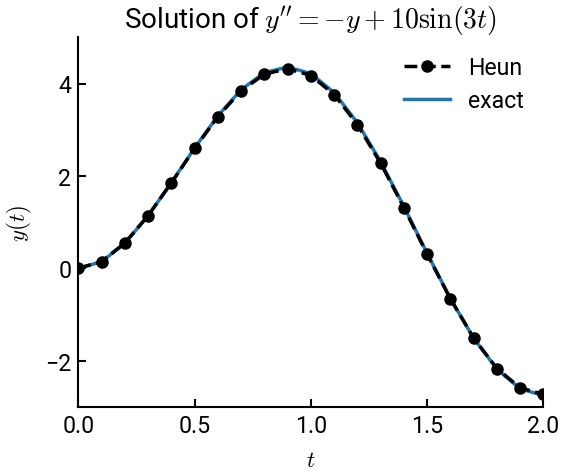Example 11-7: Heun’s method#
Since both forward and backward Euler methods are only first-order accurate, we seek a way to improve the accuracy by combining the two by averaging them. Thus begins our exploration of multi-stage algorithms that can achieve higher orders of accuracy.
Summary of commands#
No new commands are demonstrated in this exercise, but we will revisit many of the concepts from Example 11-3 to build Heun’s method.
Heun’s method#
The general idea of Heun’s method (also known as “improved Euler’s method” or “two-stage Runge-Kutta”) is to perform the update in two stages:
Now, consider the same IVP that we saw previously:
We will use Heun’s method to solve the ODE using a step size of \(h = 0.1\).
# import libraries
import numpy as np
import matplotlib.pyplot as plt
# Heun's method function
def heun(f, t0, tf, y0, h):
y = [y0]
t = np.arange(t0, tf+h, h)
for n in range(len(t) - 1):
k1 = f(t[n], y[n])
k2 = f(t[n] + h, y[n] + h * k1)
y.append(y[n] + 0.5 * h * (k1 + k2))
return t, np.array(y)
# logistic function
def my_func(t, y):
return -y + 10 * np.sin(3 * t)
# initialize
y0 = 0
t0 = 0
tf = 2
h = 0.1
# execute the Euler method solver
t, y = heun(my_func, t0, tf, y0, h)
y_exact = -3 * np.cos(3 * t) + np.sin(3 * t) + 3 * np.exp(-t)
# plot the result
fig, ax = plt.subplots()
ax.plot(t, y, 'k--o', lw=2.5, label='Heun')
ax.plot(t, y_exact, lw=2.5, label='exact', zorder=-5)
ax.set(xlabel='$t$', ylabel='$y(t)$', title=r"Solution of $y'' = -y + 10 \sin(3t)$",
xlim=[0, tf], ylim=[-3, 5])
ax.legend()
plt.show()

From which we can immediately see that Heun’s algorithm produces much more accurate results than either of the two Euler algorithms.

